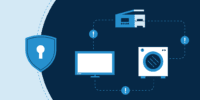What Is the Future of Wearable Iot Devices
Are you curious about the future of wearable IoT devices? Well, you’re in luck! In this article, we’ll explore the impact of these devices on healthcare, the advancements in technology, and the challenges and opportunities they present.
We’ll also discuss the potential applications of wearable IoT devices in our daily lives and delve into the security and privacy concerns surrounding them.
So, grab a cup of coffee and get ready to dive into the exciting world of wearable IoT devices!
Key Takeaways
- The future of wearable IoT devices lies in their ability to monitor vital signs and provide real-time feedback, allowing for personalized medicine and continuous monitoring for chronic conditions.
- Advancements in wearable IoT device technology include functional and fashionable designs, integration of AI technology for personalized recommendations, and the development of smartwatches, smart glasses, and smart jewelry with sleek designs and enhanced capabilities.
- The challenges and opportunities for wearable IoT devices include steady market growth and increased adoption, the integration of AI to enhance capabilities, data privacy and security concerns, battery life and power efficiency optimization, and a focus on intuitive and user-friendly design for better user experience.
- Potential applications of wearable IoT devices in daily life include tracking daily activities and monitoring health, fitness tracking features for enthusiasts and well-being improvement, heart rate monitoring and step counting, sleep pattern tracking for better sleep quality, and motivation and goal tracking for fitness goals.
Impact of Wearable IoT Devices on Healthcare
Wearable IoT devices can greatly improve your healthcare by monitoring your vital signs and providing real-time feedback on your health. These devices have the ability to remotely monitor your health, allowing healthcare professionals to keep track of your condition even when you’re not in the hospital.
This means that you can receive personalized medicine based on your specific needs and conditions. For example, if you have a chronic condition like diabetes, a wearable IoT device can continuously monitor your blood sugar levels and alert you when they are outside of the normal range. This allows you to take immediate action and prevent any potential complications.
With the help of wearable IoT devices, you can actively participate in managing your health and make informed decisions about your well-being.
Advancements in Wearable IoT Device Technology
You’ll be amazed at the recent advancements in technology for IoT devices that can be worn. Not only are these devices becoming more functional, but they are also becoming more fashionable. Companies are now focusing on creating fashion forward designs for wearable IoT devices, making them more appealing to consumers who want to stay connected while still looking stylish. Additionally, the integration of AI technology in these devices is taking them to a whole new level. AI algorithms enable these devices to learn and adapt to the user’s needs, providing personalized recommendations and insights. This integration of AI technology makes wearable IoT devices smarter and more efficient, enhancing the user experience. Check out the table below to see some examples of the latest fashion forward designs and AI integration in wearable IoT devices:
| Device | Fashion Forward Design | AI Integration |
|---|---|---|
| Smartwatch | Sleek and stylish straps | AI assistant for voice commands |
| Smart Glasses | Trendy frames | Augmented reality capabilities |
| Smart Jewelry | Elegant and modern designs | Personalized health and wellness insights |
With these advancements, wearable IoT devices are not only improving our lives but also becoming a fashion statement.
Challenges and Opportunities for Wearable IoT Devices
The challenges and opportunities facing wearable IoT devices are constantly evolving as user demands and technological advancements continue to shape the industry. Here are some key points to consider:
-
Wearable IoT device market growth: The market for wearable IoT devices has been steadily growing, with increased adoption and demand from consumers. This presents opportunities for companies to innovate and develop new products.
-
Integration of AI in wearable IoT devices: Artificial intelligence has the potential to greatly enhance the capabilities of wearable IoT devices. By incorporating AI technologies, these devices can become smarter, more intuitive, and provide personalized experiences for users.
-
Data privacy and security: With the increasing amount of personal data collected by wearable IoT devices, ensuring data privacy and security is a major challenge. Companies need to invest in robust security measures to protect user information.
-
Battery life and power efficiency: Wearable IoT devices often face challenges in terms of battery life and power efficiency. Improving battery technology and optimizing power consumption are crucial for enhancing user experience.
-
User experience and design: Creating intuitive and user-friendly interfaces is essential for the adoption and success of wearable IoT devices. Companies need to focus on designing devices that are comfortable, stylish, and easy to use.
Potential Applications of Wearable IoT Devices in Daily Life
Imagine how convenient it would be to have a device that can track your daily activities, monitor your health, and even remind you to take breaks throughout the day. Well, with fashionable wearables, this is now a reality.
These devices not only serve as fashion accessories but also offer various fitness tracking features. Whether you’re a fitness enthusiast or simply looking to improve your overall well-being, wearable IoT devices have got you covered. They can monitor your heart rate, count your steps, and even track your sleep patterns.
With just a glance at your wrist, you can stay motivated and on track towards your fitness goals. So, why not embrace the future of technology and let these fashionable wearables revolutionize your daily life?
Security and Privacy Concerns With Wearable Iot Devices
Privacy and security concerns arise when using wearable IoT devices due to the potential for personal data to be accessed or compromised. These devices, although convenient and innovative, can pose risks to your privacy and security.
Here are some key points to consider:
-
Data Encryption: Without proper encryption, your personal data transmitted through wearable IoT devices can be intercepted and accessed by unauthorized individuals.
-
User Authentication: Weak user authentication methods can make it easier for hackers to gain access to your personal information stored on these devices.
-
Lack of Security Updates: Wearable IoT devices may not receive regular security updates, leaving them vulnerable to new threats and exploits.
-
Data Breaches: In the event of a data breach, your personal information, such as health data or location history, could be exposed to malicious actors.
-
Third-party Access: Wearable IoT devices often share data with third-party apps or services, raising concerns about how your information is being used and protected.
It is crucial to prioritize your privacy and security when using wearable IoT devices. Take the necessary steps to protect your personal information, such as enabling data encryption, using strong user authentication methods, and staying informed about security updates.
Frequently Asked Questions
How Do Wearable Iot Devices Impact the Environment?
Wearable IoT devices impact the environment through their production, usage, and disposal. They contribute to e-waste and resource consumption. However, advancements in environmental sustainability and e-waste management are being made to mitigate these effects.
Are There Any Legal Regulations or Guidelines for the Use of Wearable Iot Devices?
Legal regulations and guidelines exist for the use of wearable IoT devices. They ensure privacy, security, and ethical considerations. It’s important to follow these rules to protect yourself and others while using these devices.
Can Wearable Iot Devices Be Used to Monitor and Improve Workplace Productivity?
Wearable IoT devices can be used to monitor and improve workplace productivity. They are already being used in healthcare to track vital signs and in sports performance to analyze athlete performance.
What Are the Limitations of Current Wearable Iot Device Technology?
The limitations of current wearable IoT device technology include battery life, limited processing power, and data security concerns. However, these limitations can be overcome with advancements in technology.
How Can Wearable Iot Devices Be Integrated With Other Smart Home Devices and Systems?
To integrate wearable IoT devices with other smart home devices and systems, you’ll face integration challenges, but the benefits are worth it. Consider the drawbacks, but embrace the potential for seamless connectivity and enhanced convenience.







